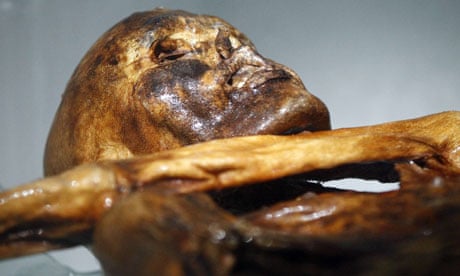As cold cases go, it does not get much colder than Ötzi the Iceman, whose body was found frozen solid in the Italian Alps 5,300 years after he died from an arrow wound.
Since he was discovered by trekkers in 1991, scientists have mapped his DNA and figured out everything from what ailments he suffered from (Lyme disease and a weak heart) to the last meal he ate (venison and ibex) before he was shot in the back, probably by an enemy tribesman.
Now, using advanced nanotechnology, they have located traces of Ötzi's blood, the oldest blood sample ever retrieved. The discovery sheds new light on his death and may change the way police study blood found at modern crime scenes.
"Up to now there had been uncertainty about how long blood could survive, let alone what human blood cells from the Chalcolithic period – the Copper Stone Age – might look like," said Albert Zink, of the Institute for Mummies and the Iceman in Bolzano, Italy, where Ötzi's body is kept at minus 6C.
Using an atomic microscope and a spectroscope, an Italo-German team found tiny traces of blood similar to modern-day blood around the arrow wound and a cut to Ötzi's hand.
"Forensic scientists today have trouble telling if crime scene blood is days or months old, but by studying the elasticity of 5,000-year-old blood we hope to be able to make a real contribution to the understanding of blood aging," Zink said.
The team also found fibrin, a protein involved in blood clotting, in the arrow wound. "Fibrin is produced by the body at the moment of wounding and later replaced during the healing process," Zink said. "What we found shows he died within 30 minutes of being shot."
